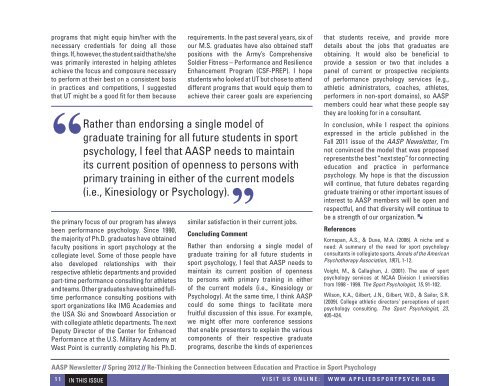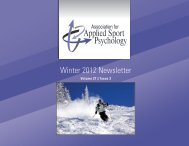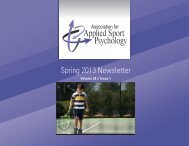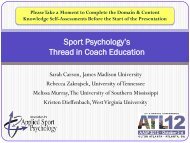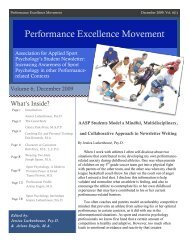Spring 2012 Newsletter - Association for Applied Sport Psychology
Spring 2012 Newsletter - Association for Applied Sport Psychology
Spring 2012 Newsletter - Association for Applied Sport Psychology
Create successful ePaper yourself
Turn your PDF publications into a flip-book with our unique Google optimized e-Paper software.
programs that might equip him/her with the<br />
necessary credentials <strong>for</strong> doing all those<br />
things. If, however, the student said that he/she<br />
was primarily interested in helping athletes<br />
achieve the focus and composure necessary<br />
to per<strong>for</strong>m at their best on a consistent basis<br />
in practices and competitions, I suggested<br />
that UT might be a good fit <strong>for</strong> them because<br />
the primary focus of our program has always<br />
been per<strong>for</strong>mance psychology. Since 1990,<br />
the majority of Ph.D. graduates have obtained<br />
faculty positions in sport psychology at the<br />
collegiate level. Some of those people have<br />
also developed relationships with their<br />
respective athletic departments and provided<br />
part-time per<strong>for</strong>mance consulting <strong>for</strong> athletes<br />
and teams. Other graduates have obtained fulltime<br />
per<strong>for</strong>mance consulting positions with<br />
sport organizations like IMG Academies and<br />
the USA Ski and Snowboard <strong>Association</strong> or<br />
with collegiate athletic departments. The next<br />
Deputy Director of the Center <strong>for</strong> Enhanced<br />
Per<strong>for</strong>mance at the U.S. Military Academy at<br />
West Point is currently completing his Ph.D.<br />
requirements. In the past several years, six of<br />
our M.S. graduates have also obtained staff<br />
positions with the Army’s Comprehensive<br />
Soldier Fitness – Per<strong>for</strong>mance and Resilience<br />
Enhancement Program (CSF-PREP). I hope<br />
students who looked at UT but chose to attend<br />
different programs that would equip them to<br />
achieve their career goals are experiencing<br />
Rather than endorsing a single model of<br />
graduate training <strong>for</strong> all future students in sport<br />
psychology, I feel that AASP needs to maintain<br />
its current position of openness to persons with<br />
primary training in either of the current models<br />
(i.e., Kinesiology or <strong>Psychology</strong>).<br />
similar satisfaction in their current jobs.<br />
Concluding Comment<br />
Rather than endorsing a single model of<br />
graduate training <strong>for</strong> all future students in<br />
sport psychology, I feel that AASP needs to<br />
maintain its current position of openness<br />
to persons with primary training in either<br />
of the current models (i.e., Kinesiology or<br />
<strong>Psychology</strong>). At the same time, I think AASP<br />
could do some things to facilitate more<br />
fruitful discussion of this issue. For example,<br />
we might offer more conference sessions<br />
that enable presenters to explain the various<br />
components of their respective graduate<br />
programs, describe the kinds of experiences<br />
that students receive, and provide more<br />
details about the jobs that graduates are<br />
obtaining. It would also be beneficial to<br />
provide a session or two that includes a<br />
panel of current or prospective recipients<br />
of per<strong>for</strong>mance psychology services (e.g.,<br />
athletic administrators, coaches, athletes,<br />
per<strong>for</strong>mers in non-sport domains), so AASP<br />
members could hear what these people say<br />
they are looking <strong>for</strong> in a consultant.<br />
In conclusion, while I respect the opinions<br />
expressed in the article published in the<br />
Fall 2011 issue of the AASP <strong>Newsletter</strong>, I’m<br />
not convinced the model that was proposed<br />
represents the best “next step” <strong>for</strong> connecting<br />
education and practice in per<strong>for</strong>mance<br />
psychology. My hope is that the discussion<br />
will continue, that future debates regarding<br />
graduate training or other important issues of<br />
interest to AASP members will be open and<br />
respectful, and that diversity will continue to<br />
be a strength of our organization.<br />
References<br />
Kornspan, A.S., & Duve, M.A. (2006). A niche and a<br />
need: A summary of the need <strong>for</strong> sport psychology<br />
consultants in collegiate sports. Annals of the American<br />
Psychotherapy <strong>Association</strong>, 19(7), 1-12.<br />
Voight, M., & Callaghan, J. (2001). The use of sport<br />
psychology services at NCAA Division I universities<br />
from 1998 - 1999. The <strong>Sport</strong> Psychologist, 15, 91-102.<br />
Wilson, K.A., Gilbert, J.N., Gilbert, W.D., & Sailor, S.R.<br />
(2009). College athletic directors’ perceptions of sport<br />
psychology consulting. The <strong>Sport</strong> Psychologist, 23,<br />
405-424.<br />
AASP <strong>Newsletter</strong> // <strong>Spring</strong> <strong>2012</strong> // Re-Thinking the Connection between Education and Practice in <strong>Sport</strong> <strong>Psychology</strong><br />
11 In This Issue<br />
Visit us Online:<br />
www.appliedsportpsych.org


